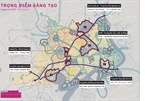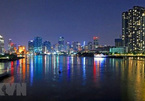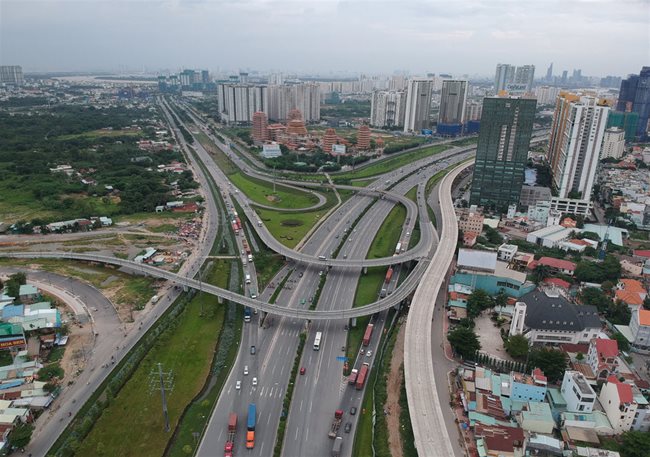|
The Government leader appreciated this initiative. In the current situation, it can be seen as an idea of national strategic importance.
If successfully developed, the Eastern Creative City will help solve two strategic issues of Vietnam, namely creating a new wave of innovation-based growth in Industry 4.0 and enhancing the national defense capacity amid complex developments of the regional and international situation. It is now an appropriate time to realize this initiative, as the trend of moving the global supply chain out of China is accelerated by Covid-19, and HCMC, the country’s economic hub with the tradition of pioneering with breakthrough ideas, is eager to regain its status. From the experience of realizing similar ideas in other countries, especially Gangnam City on the southern bank of the Han River in Seoul, South Korea, and Pudong City in Shanghai, China, the Eastern Creative City should be seen as a national key project with special mechanisms regarding openness to the outside world, selection of strategic partners and necessary autonomy to enable HCMC to bring into play its capacity and potential. Comparison with Gangnam and Pudong The Eastern Creative City is planned to cover the three districts of 2, 9 and Thu Duc with an area of 212 square kilometers, equivalent to the urban development on the southern bank of the Han River in the late 1960s and half of Pudong in the early 1990s. The three districts currently have a combined population of nearly 1.2 million, larger than the population of Gangnam and smaller than that of Pudong in the early stage. The population of Seoul is nearly 4.1 million in 1967 and over 24 million now (regionwide). The population of Shanghai is 7.8 million in 1990 and more than 22 million now. The current population in southern Seoul is about five million and in Pudong over 5.5 million (equivalent to Singapore’s population) and the area is more than 1,200 square kilometers (same as Hong Kong’s area). The current population of the HCMC region is nearly 11 million. With the development trend and urbanization like other countries, the city’s population over the next three decades should be around 20-30 million. Gangnam is now the new center of Seoul and an innovative hub of South Korea, with the birth of the legendary Gangnam Style dance and the headquarters of many big international corporations. After three decades of development, Pudong has become a pride of China and a foundation to build her global competitiveness. Its GDP in 2019 is nearly US$185 billion, equivalent to 50% of Singapore’s GDP, 70% of Vietnam’s GDP and more than three times as much as that of HCMC. Compared with the initial stages of Gangnam and Pudong, the Eastern Creative City has more favorable conditions, with basically completed internal infrastructure and connections and large areas available for development. The essential facilities of the Thu Thiem financial and commercial center are ready and the high-tech park has a firm position. Gangnam In the 1960s, the southern bank of the Han River was a thinly-populated agricultural area for cabbage and pear farming. The success of Gangnam proves the right strategy of South Korea in general and Seoul in particular in the creation of the Han River miracle. More and more people moved to Seoul when economic development policies focusing on central cities (the Seoul-Busan corridor) of President Park Chung-Hee, starting with the first five-year plan (1963-1968), began to bear fruit. In the period 1961-1970, the population of Seoul increased an average 300,000 per year, with the peak of 500,000 in 1970. In three decades (1961-1990), the absolute increase is nearly 8.2 million, more than three times of the figure in 1960. To meet the development demand and ensure housing for the population, the Seoul Development Plan was introduced in 1966, with the southern bank of the Han River as a center. The South Korean Government and Seoul authorities adopted the market and urban operation principles and the enabling government approach to implement push-pull policies, such as concentrating on building internal infrastructure and connections, limiting construction in the northern bank, relocating some government agencies to the southern bank, incentivizing investors and restricting property speculation. Despite some initial challenges, Gangnam City has gained tremendous success and possessed its current status. Pudong Chinese Prime Minister Li Peng officially announced his support for development of Pudong on April 18, 1990 when he attended the fifth anniversary of Volkswagen auto plant in Shanghai, a city seen as China’s dragon head. However, it was a long process to come to that official date of Pudong establishment. The potential of Pudong was mentioned by Sun Yat Sen, the leader of China’s national, democratic and people’s revolution in the 1920s. However, it was still potential. When China opened her door to the world in 1978, Pudong was not chosen as a special zone due to the protest by the conservatives, especially Deputy Prime Minister Sun Jian, the second most powerful figure in China at that time. After the Tiananmen Square incident, Deng Xiaoping opted for Pudong development to deliver to the world the message that China still continued her reform and open-door policy. Zhu Rongji, who was then Shanghai mayor and the supporter for this process, was seen as the mastermind of the project together with Deng. Pudong was put in the list of national key projects because of its importance. The city has four main components: the financial and commercial center, the high-tech park, the export processing zone and the free trade zone. The financial center and the high-tech park are the most important highlights. The dynamism, creativity and resolution of Shanghai authorities played a very important role, but the success of the project was determined by the central Government, with the adoption of policies for a global city regarding various areas like requirements for financial operations, capital movement, talent recruitment and technology transfer. Regarded as the chief architect of China’s reform and open-door efforts, Deng Xiaoping’s decisions to select the right team of successors and strategic breakthroughs for China, including the Pudong development, are wise choices with long-term vision after Deng’s more than a decade at the helm of the country. His decisions are the fundamental to build up the position and prestige of China today. To sum up, a monumental initiative has been put forward in HCMC. It has strategic significance for national development; so the central Government should issue policies and give HCMC enough leeway and autonomy for successful development. What matters now is the city authorities should have thorough preparation so that the central Government can get full information and convincement for decision making. SGT |
||
Huynh The Du

HCM City adjusts zoning plan for innovative hub
The HCM City Department of Planning and Architecture has proposed a 1:2000 scale for zoning of three areas in the eastern part of the city.

HCM City to merge three districts to create innovative hub
The HCM City Department of Home Affairs has submitted a plan to the People's Committee on the merger of three districts and 19 wards in the eastern side of the city.
 HCMC authorities put forward a proposal to develop the Eastern Creative City during a working session with the Prime Minister early this month.
HCMC authorities put forward a proposal to develop the Eastern Creative City during a working session with the Prime Minister early this month. 